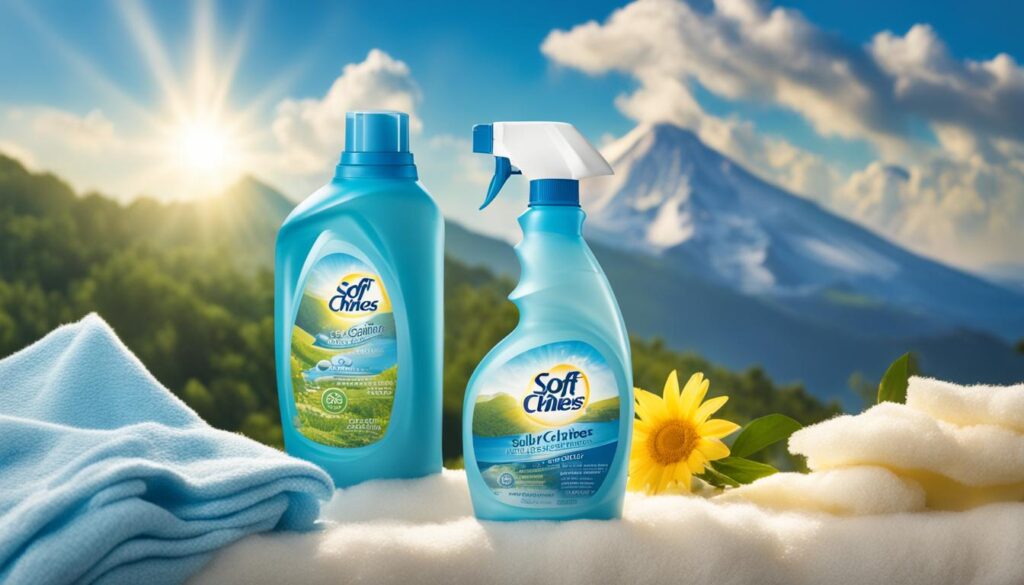Welcome to our comprehensive guide on choosing the best fabric conditioner for your laundromat. As a laundromat owner, it’s crucial to provide your customers with soft, fresh-smelling clothes that enhance their laundry experience. In this article, we will discuss the benefits of using fabric softeners, provide tips for choosing the right one, and address common concerns about using fabric conditioners in laundromats.
Key Takeaways:
- Choosing an appropriate fabric conditioner is essential for maintaining high-quality laundry services in your laundromat.
- Consider factors such as price, effectiveness, and special features when comparing different fabric conditioner brands.
- Look for fabric softeners with natural ingredients and special formulations tailored to your customers’ needs.
- Fabric conditioners help keep clothes soft, reduce static cling, and minimize wrinkles.
- Bulk Comfort fabric softener is highly recommended for laundromat businesses due to its cleaning power, odor control, and cost-effectiveness.
Tips for Choosing the Best Fabric Softener
When it comes to selecting the best fabric softener for your laundromat, there are several factors to consider. We understand the importance of providing your customers with soft and fresh-smelling clothes, while also prioritizing affordability and sustainability. Here are some tips to help you make an informed choice:
- Compare prices: Take the time to shop around and compare prices from different suppliers. This will help you find the best value for your money and ensure you stay within your budget.
- Look for effective formulas: Choose a fabric softener that is known for its effectiveness in softening fabrics. Look for natural ingredients like aloe vera or silk protein, which provide effective softening without causing damage to the fabrics.
- Consider special features: Take into account any specific needs or preferences of your customers. If your clientele includes individuals with sensitive skin or allergies, consider fragrance-free or scent-free fabric softeners. Additionally, opt for color-safe formulas to prevent any unfortunate color bleeding mishaps.
By considering these tips, you can confidently select the best fabric softener for your laundromat that not only delivers excellent results but also meets the diverse needs of your customers.
“Choosing the right fabric softener is crucial for maintaining customer satisfaction and loyalty. By offering the best fabric softening experience, you can ensure that your customers keep coming back for fresh, soft, and beautifully scented clothes.”
The Benefits of Using Fabric Softeners
Fabric softeners are essential for any laundry business, providing numerous benefits that enhance the quality of your services and improve customer satisfaction. By incorporating fabric softeners into your laundry routine, you can achieve soft and fluffy clothes, prevent static cling, and reduce wrinkles in fabrics.
One of the primary advantages of fabric softeners is their ability to make clothes and linens feel incredibly soft. The softening agents in fabric softeners help to relax the fibers in the fabric, resulting in a luxurious, velvety texture that customers will love. Whether it’s towels, bedding, or clothing, fabric softeners ensure that every item feels delightful against the skin.
Static cling can be a nuisance, especially in colder months. Fabric softeners effectively neutralize static charges, preventing clothes from clinging together or sticking to the body. This not only makes it easier to fold and organize laundry but also eliminates the discomfort caused by static electricity.
Additionally, fabric softeners work wonders in reducing wrinkles in fabrics. The conditioning agents in fabric softeners relax the fibers and ease out any creases, resulting in garments that look smooth and well-maintained. This saves time and effort in ironing, making clothes ready to wear straight from the dryer.
Using high-quality fabric softeners for your laundry business can significantly enhance the overall laundry experience for your customers. They will appreciate the softness and freshness of their clothes and linens, making them more likely to return for your services. Moreover, fabric softeners help to maintain the longevity of fabrics by minimizing wear and tear, extending the lifespan of customers’ favorite garments.
When selecting fabric softeners for your laundry business, opt for trusted brands that are specifically designed for commercial use. These fabric softeners are formulated to deliver superior results, ensuring that your customers’ clothes are soft, static-free, and wrinkle-resistant.
| Benefits of Fabric Softeners | |
|---|---|
| Soft and fluffy clothes | Fabric softeners make clothes incredibly soft, providing a luxurious feel against the skin. |
| Prevent static cling | Fabric softeners neutralize static charges, eliminating the annoyance of clothes sticking together or to the body. |
| Reduce wrinkles in fabrics | The conditioning agents in fabric softeners relax fibers and reduce creases, resulting in wrinkle-free garments. |
By incorporating fabric softeners into your laundry business, you can enhance the quality of your services, delight your customers with soft and fresh clothes, and differentiate yourself from competitors. Start using fabric softeners today and experience the difference they make in your laundry business.
Can Wholesale Fabric Softener Damage Your Washing Machines?
There has been some concern about the potential damage that wholesale fabric softeners can cause to washing machines. However, it’s important to note that there is no concrete evidence to support these claims. Proper maintenance and care of your washing machines can go a long way in preventing any negative effects.
Proper Maintenance of Washing Machines:
- Regular cleaning: Keep the drum, detergent dispenser, and filters clean from any residue or fabric softener buildup. This will ensure optimal performance and prevent any potential issues.
- Follow manufacturer’s instructions: Always refer to the manufacturer’s guidelines for proper usage and maintenance of your specific washing machine model.
- Use recommended products: Stick to using high-quality fabric softeners from trusted suppliers like Unilever Professional, who offer the best quality and quantity in professional bulk fabric softeners.
By following these simple steps, you can ensure that your washing machines are well-maintained and protected from any potential damage that may be associated with fabric softeners. Remember, proper maintenance is key to the longevity and efficiency of your machines.
Why Bulk Comfort Fabric Softener is the Best for Your Laundromat Business
When it comes to running a successful laundromat business, the choice of fabric softener can make a significant difference. That’s where Bulk Comfort fabric softener stands out from the competition. With its exceptional cleaning power, unbeatable odor control, long-lasting freshness, and cost-effectiveness, Bulk Comfort is the ultimate choice for laundromat owners.
Here’s why Bulk Comfort fabric softener is the best option for your business:
- Cleaning Power: Bulk Comfort fabric softener goes beyond mere softening. Its powerful formula penetrates deep into the fibers of the clothes, removing tough stains and ensuring a thorough clean with every wash.
- Odor Control: Say goodbye to unpleasant odors! Bulk Comfort fabric softener leaves clothes smelling fresh and fragrant, eliminating any lingering odors and ensuring that your customers’ laundry experience is delightful.
- Long-Lasting Freshness: With Bulk Comfort fabric softener, the freshness lasts longer. Clothes retain their exceptional scent even after multiple wearings, enhancing customer satisfaction and loyalty.
- Cost-Effective: We understand that managing costs is crucial for your laundromat business. Bulk Comfort fabric softener offers excellent bulk pricing options, allowing you to reduce expenses without compromising on quality.
Image:
“Bulk Comfort fabric softener is the perfect solution for laundromat owners looking to deliver exceptional laundry results while maintaining cost-effectiveness.”
Don’t settle for anything less than the best for your laundromat business. Choose Bulk Comfort fabric softener and provide your customers with the softest, freshest, and most beautifully scented laundry experience possible.
Frequently Asked Questions about Choosing Fabric Softener for Laundromats
As experts in the laundry industry, we understand that choosing the right fabric softener for your laundromat can be a daunting task. To help you make an informed decision, we have compiled a list of frequently asked questions about fabric softeners for laundromats.
Do all laundromats use fabric softeners?
While not all laundromats use fabric softeners, incorporating them into your laundry routine can significantly enhance the quality of your customers’ clothing and linens. Fabric softeners help to maintain the softness, eliminate static cling, and reduce wrinkles in fabrics, leaving them looking and feeling their best.
What types of fabric softeners are needed for laundromats?
The type of fabric softener you choose for your laundromat depends on several factors, including the needs of your customers and the types of fabrics being washed. Here are some common types of fabric softeners:
- Liquid fabric softeners: These are popular for their ease of use and ability to provide softness and fragrance to a range of fabrics.
- Fabric softener sheets: These sheets are added to the dryer and work by releasing softening agents and fragrance as the clothes tumble.
- Dryer balls: These reusable balls are tossed into the dryer with the laundry and help to soften fabrics, reduce static, and decrease drying time.
By offering a variety of fabric softener options, you can cater to the diverse preferences of your customers and provide them with a satisfying laundry experience.
What fabric softener supplies do laundromats need?
In addition to fabric softeners, there are a few essential supplies that laundromats need to ensure a seamless fabric softening process. These supplies include:
- Fabric softener sheets: These sheets are a must-have for laundromat customers who prefer the convenience of using them in the dryer.
- Liquid fabric softener: Stocking liquid fabric softener allows customers to add it during the wash cycle to achieve optimal softness.
- Dryer balls: Providing dryer balls gives customers the option to use them in the dryer to naturally soften fabrics and reduce static cling.
Having these fabric softener supplies readily available in your laundromat ensures that your customers have everything they need to achieve soft, fresh-smelling laundry.
What is Fabric Conditioner and Why Use It?
Fabric conditioner is an essential after-care product for your clothes that enhances their feel and manageability. When used in the laundry process, fabric conditioner coats the fibers with a light film, making them soft, smooth, and wrinkle-free. By reducing friction between the fibers, fabric conditioner enhances the overall laundry experience and helps maintain the quality of your garments.
Using fabric conditioner after regular detergent ensures that your clothes are not only clean but also exceptionally soft and easy to manage. It adds an extra layer of care that enhances the fabric feel, making the clothes more comfortable to wear. The gentle coating detangles the fibers, making it easier to iron or fold your garments, saving you time and effort in your daily routine.
For best results, choose a fabric conditioner that is compatible with your garments and suits your personal preferences. Whether you prefer a fragrant or fragrance-free option, fabric conditioner enhances the sensory experience of wearing freshly laundered clothes. With fabric conditioner, you can enjoy the sensation of beautifully conditioned fabrics against your skin, elevating the comfort level of your clothes to a new level.
“Fabric conditioner enhances the feel and manageability of clothes by coating them with a light film.”
Trustworthy brands like Downy and Snuggle offer a range of fabric conditioners that cater to different fabric types and personal preferences. From hypoallergenic options to plant-based formulas, there are fabric conditioners available for everyone. Explore the variety of options and discover the perfect fabric conditioner that suits your clothing care needs.
Next, we will discuss which kind of fabric conditioner you should use and how to choose the right one for your needs. We will also explore the benefits of using fabric conditioner for specific materials and how to incorporate it into your laundry routine.
Which Kind of Fabric Conditioner Should You Use?
When it comes to choosing a fabric conditioner, it’s important to opt for options that are not only gentle on fabrics but also environmentally friendly. Avoid fabric conditioners that contain harmful ingredients like chemical dyes and optical brighteners. Instead, consider using natural fabric conditioners that are plant-based and eco-friendly. These options will not only soften and protect your natural fibers but also minimize the negative impact on the environment.
Here are some gentle and eco-friendly fabric conditioner options to consider:
| Fabric Conditioner | Description |
|---|---|
| Gentle and Pure Fabric Softener | A natural fabric conditioner made with plant extracts and essential oils. Free from harsh chemicals and synthetic fragrances. |
| Eco-Friendly Fabric Conditioner | A biodegradable fabric conditioner that is gentle on clothes and safe for the environment. It is made from renewable resources and does not contain any harmful additives. |
| Naturally Soft Fabric Conditioner | A hypoallergenic fabric conditioner that is perfect for those with sensitive skin. It is free from artificial dyes, fragrances, and other common allergens. |
By choosing these gentle and eco-friendly fabric conditioners, you can ensure that your clothes stay soft and fresh without compromising the well-being of your fabrics or the environment.
What Kind of Clothes and Materials Benefit from Fabric Conditioner?
Fabric softeners are a great addition to your laundry routine, providing numerous benefits to a wide range of clothing materials. However, it’s important to note that there are certain items that should be excluded from using fabric conditioner. Let’s explore the fabrics that benefit from fabric conditioner and those that should avoid it.
Fabrics that Benefit from Fabric Conditioner
Fabric softeners work exceptionally well on most clothing fibers, bringing softness and enhancing the overall feel and appearance of garments. Here are some fabrics that benefit from fabric conditioner:
- Cotton: One of the most common clothing materials, cotton garments are known for their breathability and durability. Fabric conditioner adds an extra layer of softness to cotton clothes, making them more comfortable to wear.
- Linen: Linen fabrics tend to wrinkle easily, but fabric conditioner can help reduce wrinkles, keeping your linen clothes looking crisp and fresh.
- Silk: Luxurious and delicate, silk garments can benefit from fabric conditioner as it helps maintain their smoothness and prevents them from becoming stiff.
- Wool: Wool can sometimes feel itchy and rough, but fabric conditioner can help soften woolen clothes, making them more enjoyable to wear.
Avoiding Fabric Conditioner for Certain Items
“When it comes to certain items, it’s best to avoid using fabric conditioner. This includes microfiber cloths, sportswear, flame-resistant clothing, water-resistant items, and synthetic fabrics like polyester.”
Microfiber cloths, such as those used for cleaning or drying purposes, can lose their absorbency when exposed to fabric conditioner. Similarly, sportswear made from performance fabrics often have special moisture-wicking properties that can be compromised by fabric conditioner.
Flame-resistant clothing, designed to offer fire protection, can have its flame resistance diminished by fabric conditioner. Water-resistant items, like raincoats or outdoor gear, may lose their water repellency when treated with fabric conditioner.
Finally, synthetic fabrics like polyester are already designed to be soft and wrinkle-resistant, so fabric conditioner is not necessary and may affect their performance.
By being aware of the specific fabrics that benefit from fabric conditioner and avoiding its use on certain items, you can ensure that your clothes and materials receive optimal care to maintain their quality and longevity.
Where Does the Fabric Conditioner Go?
When it comes to using fabric conditioner, you have a couple of options depending on your washing method. Whether you’re using a washing machine or handwashing, there are different ways to add fabric conditioner and ensure optimal results.
Adding Fabric Conditioner to the Washing Machine
If you’re using a washing machine, the most common way to incorporate fabric conditioner is during the rinse cycle. Many modern washing machines come equipped with a fabric softener dispenser, making it easy to add the conditioner at the right time. Simply follow these steps:
- Check your washing machine for a fabric softener dispenser. It is usually located near the detergent drawer.
- Pour the recommended amount of fabric conditioner into the dispenser. Be sure to check the manufacturer’s instructions for the correct dosage.
- Start your washing machine and choose the appropriate wash cycle.
- The fabric softener will be automatically released during the rinse cycle, ensuring that your clothes come out soft and fresh.
If your washing machine doesn’t have a fabric softener dispenser, you can still add fabric conditioner manually. Simply wait for the rinse cycle to begin, then pause the machine and follow these steps:
- Measure the recommended amount of fabric conditioner.
- Add the fabric conditioner directly into the drum of the washing machine.
- Resume the washing cycle and let the machine complete its cycle.
Remember not to pour fabric conditioner directly onto your clothes, as it may cause staining. Follow the manufacturer’s instructions for the best results with your specific washing machine model.
Using Fabric Conditioner for Handwashing
If you prefer to handwash your delicate items, you can still enjoy the benefits of fabric conditioner. Here’s how:
- Fill a basin or sink with water at a suitable temperature for your garments.
- Add the recommended amount of fabric conditioner to the water. Be sure to read the product instructions for the proper dosage.
- Swirl the water gently to distribute the fabric conditioner.
- Submerge your clothes in the water and allow them to soak for the recommended amount of time.
- After soaking, remove the clothes from the water and gently squeeze out any excess moisture.
- Do not rinse or wring the clothes. Instead, lay them flat on a clean towel to dry.
Handwashing with fabric conditioner will leave your clothes feeling soft and smelling fresh, just like they would if washed in a machine.
Adding fabric conditioner to your washing machine or using it for handwashing can greatly improve the softness and freshness of your clothes.
Why Is Your Machine Not Taking Fabric Conditioner?
If you’re experiencing issues with your washing machine not taking fabric conditioner, there are a few potential causes to consider. One common reason is a build-up of residue in the fabric softener dispenser, which can prevent proper dispensing. Cleaning the dispenser thoroughly can help resolve this issue.
Another factor to examine is the water pressure in your machine. Low water pressure can affect the distribution of fabric conditioner, leading to it not being dispensed effectively. Check that the water pressure in your washing machine meets the manufacturer’s recommended levels.
Additionally, the level of your machine can impact the distribution of fabric conditioner. If your washing machine is not properly leveled, it can interfere with the flow and prevent the fabric conditioner from being dispensed correctly. Adjusting the machine’s level can help alleviate this problem.
By addressing these potential causes, you can ensure that your washing machine dispenses fabric conditioner properly, resulting in soft and fresh-smelling laundry.
Troubleshooting Guide for Fabric Conditioner Dispensing Issues
| Possible Causes | Solutions |
|---|---|
| Build-up in fabric softener dispenser | Clean the dispenser thoroughly |
| Low water pressure | Check and adjust water pressure in the machine |
| Improper machine level | Adjust the level of the washing machine |
Regular maintenance and troubleshooting can help ensure that your washing machine operates smoothly, providing optimal results with fabric conditioner.
How to Use Dryer Sheets and Dryer Balls with Fabric Softener
When it comes to achieving soft and fresh-smelling laundry, using dryer sheets and dryer balls can be a game-changer. These handy laundry accessories work in tandem with fabric softener to provide optimal results. By following these tips, you can ensure that your clothes come out perfectly soft and free from fabric softener stains.
Using Dryer Sheets
Dryer sheets are an easy and convenient way to infuse your laundry with a delightful scent while reducing static cling. To use dryer sheets effectively:
- Place the desired number of dryer sheets on top of the load of laundry in the dryer.
- Close the dryer door, and start the drying cycle as usual.
- Allow the dryer sheets to work their magic as they release fragrance and reduce static.
With dryer sheets, your clothes will come out of the dryer feeling soft, smelling fresh, and free from static electricity.
Using Dryer Balls
Dryer balls are another fantastic option for enhancing the softness of your laundry and reducing static. There are two types of dryer balls available: wool dryer balls and plastic dryer balls.
Wool dryer balls are natural and eco-friendly. They work by creating space between the clothes, allowing hot air to circulate more efficiently, which results in shorter drying times and reduced wrinkles. Additionally, they help soften fabrics, making your clothes feel luxuriously soft.
Plastic dryer balls, on the other hand, are designed to prevent clothes from tangling and improve airflow in the dryer, resulting in faster and more even drying. While plastic dryer balls don’t offer the same softening benefits as wool ones, they are an excellent option for reducing static cling.
To use dryer balls:
- Place the desired number of dryer balls in the drum of your dryer.
- Add your clothes and start the drying cycle as usual.
- Allow the dryer balls to tumble with the clothes, gently separating them and reducing the likelihood of static cling.
Using dryer balls in combination with fabric softener will help distribute the softening benefits evenly throughout your laundry.
| Product | Benefits |
|---|---|
| Wool Dryer Balls |
|
| Plastic Dryer Balls |
|
By using dryer sheets or dryer balls, you can enhance the softness, reduce static cling, and achieve the perfect results with fabric softener, making your clothes feel and smell amazing.
Whether you prefer dryer sheets or dryer balls, incorporating them into your laundry routine will elevate the softness and freshness of your clothes. Experiment with different combinations to find the perfect balance that suits your preferences and laundry needs.
Conclusion
Choosing the right fabric softener for your laundromat is key to enhancing your customers’ laundry routine and ensuring their satisfaction. Fabric softeners play a vital role in enhancing the softness, smell, and appearance of clothes, making them an essential part of any laundry business.
By offering high-quality fabric softeners, you can provide your customers with the best laundry care experience. Consider factors such as price, effectiveness, and special features when selecting a fabric softener for your laundromat. Compare different brands and formulations to find one that fits your budget and meets your laundry needs.
With the right fabric softener, you can create soft and fluffy clothes, prevent static cling, and reduce wrinkles in fabrics. This not only improves the overall quality of your laundry services but also enhances customer satisfaction. So, invest in the right fabric softener for your laundromat and take your laundry business to the next level.
FAQ
Can I use fabric softener in my laundromat?
Yes, fabric softeners are commonly used in laundromats to keep clothes soft, reduce static cling, and minimize wrinkles.
What should I consider when choosing a fabric softener for my laundromat?
When choosing a fabric softener, consider factors such as price, effectiveness, and special features. Compare different brands and formulations to find one that fits your budget and meets your laundry needs.
What types of fabric softeners are recommended for laundromats?
It depends on the needs of your customers and the types of fabrics being washed. Important fabric softener supplies for laundromats include sheets, liquid fabric softener, and dryer balls.
How does fabric conditioner enhance the feel of clothes?
Fabric conditioner coats clothes with a light film, making them soft, smooth, and wrinkle-free by reducing friction between fibers.
Are there any fabrics that should not be treated with fabric softener?
Yes, fabrics such as microfiber cloths, sportswear, flame-resistant clothing, water-resistant items, and synthetic fabrics like polyester may be negatively affected by fabric softeners and experience reduced performance.
Where should I add fabric conditioner in the washing machine?
Fabric conditioner can be added during the rinse cycle using the fabric softener dispenser or directly in the drum during handwashing. Follow the manufacturer’s instructions and avoid pouring fabric conditioner directly onto clothes to prevent staining.
My washing machine is not taking fabric conditioner. What should I do?
If your washing machine is not taking fabric conditioner, it could be due to a build-up in the fabric softener dispenser. Cleaning the dispenser and ensuring proper water pressure and machine level can solve this problem effectively.
How can I use dryer sheets and dryer balls with fabric softener?
Dryer sheets can be used by placing them on top of the load of laundry in the dryer, while wool or plastic dryer balls can be added to the drum to reduce static. Proper usage of these products will help distribute fabric softener evenly without causing stains.







